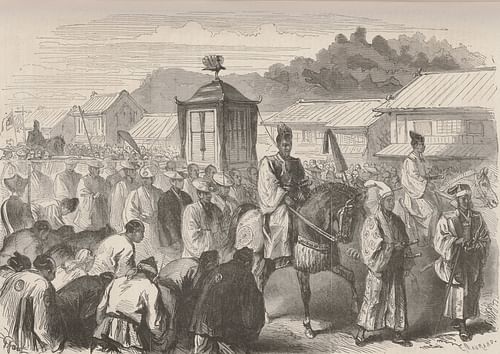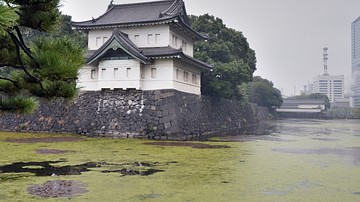
The Meiji period refers to the period in Japanese history from 1868 to 1912 during which the Meiji Emperor reigned. Following the overthrow of the Tokugawa shogunate in the Meiji Restoration of 1868, Japan's new leaders embarked on a program of radical reform aimed at strengthening the country so it could resist the threat of European imperialism.
A new political structure modelled on those in Europe was put in place and the country rapidly industrialised. Building a modern army and navy, Japan successfully fought wars against China and Russia in 1894 and 1905, respectively. By the end of the Meiji period, Japan was not only the strongest country in East Asia but was also a world power.
Tokugawa Heritage
Both contemporary foreign observers and subsequent generations of historians were surprised by the speed with which Japanese society changed during the Meiji period. This had a lot to do with the way Europeans tended to view other countries. The 19th century was an era of 'scientific racism' in Europe, and many people believed that Europeans were innately superior to Asians. Parts of Europe had just gone through the Industrial Revolution, and the standard of living and level of technology there was much higher than it was in other parts of the world. Despite outward appearances, however, changes that had taken place in Japanese society during the Edo period (1603-1867) made the country well-prepared to deal with the threat from European powers.
Japan had been at peace for 250 years, and in general, the country was well governed. Japan had a decentralised system of government in which power was divided between the bakufu, a warrior government controlled by the Tokugawa family, and about 270 daimyo families that ruled their own territories called han. While Japan was politically divided, it had a nationally integrated transportation system and economy. Although the Japanese economy was based on agriculture, there was the large-scale, proto-industrial production of a number of important commodities including cotton, silk, paper, wax and salt.
The level of education in Japan was generally high by the standards of the day. During the Edo period, the warrior class had been transformed from fighters to civil administrators. Many daimyo had established local schools to educate the children of their warrior retainers so that they would have the skills necessary to carry out their duties as local officials. Many commoners also got an education through private schools called terakoya. The rate of literacy was greatly assisted by the development of woodblock printing, and an intellectual elite appeared who were well-versed in the sophisticated theories of Neo-Confucianism. Although the Tokugawa fundamentally did not allow free speech, these intellectuals had the capacity to analyse and understand complex social and political problems.
The Threat of European Imperialism
During the Edo period, the Tokugawa imposed a policy of national isolation on the country. Japanese were restricted from going abroad, and the only foreigners allowed to come to Japan were from China, Korea, and the Netherlands. The Dutch were restricted to a trading post in Nagasaki. The government had been able to implement this exclusion policy in the 1630s because the level of technology in Japan and in foreign countries was roughly the same. From the late 18th century, however, some European countries, notably Great Britain, began to experience the Industrial Revolution. This gave these countries a technological edge when dealing with those in other parts of the world.
At about the same time, Great Britain, France, Russia, and the United States began to send ships to Japan, attempting foreign trade. The Tokugawa initially rebuffed all of these, but in 1852, the American Commander Matthew Perry led a fleet of armed steam-powered ships demanding the country open up. The Tokugawa felt unable to resist this demand and signed a treaty with the US allowing the opening of some ports and the entry of some foreigners to Japan. Treaties with other European powers followed. This enraged opponents of the government who wanted to maintain the policy of national isolation. They used the slogan "revere the emperor, expel the barbarians" to call for the overthrow of the Tokugawa, the restoration of political authority to the imperial family and the expulsion of foreigners.

In response to attacks on foreign ships, European naval vessels bombarded some Japanese ports. It became clear that 'expelling the barbarians' was not something that could be easily achieved and an alternate strategy for dealing with the foreign threat needed to be developed. The Tokugawa government put some effort into trying to improve Japan's military preparedness, but before much could be achieved, it was overthrown by a coalition of forces from Choshu, Satsuma, and Tosa han.
These events are usually conceptualised in terms of Japan's confrontation with the West, but such a view ignores the fact that the countries that made up the West were quite diverse. Not only did Great Britain, France, Germany, Russia, and the United States all have different social and political systems but they were also rivals on the international scene who fought with each other.
The New Government
Although the bakufu had been overthrown in the name of restoring direct rule by the imperial family, real power was in the hands of the people that had led the rebellion. These included Okubo Toshimichi (1830-1878) and Saigo Takamori (1822-1877) from Satsuma and Ito Hirobumi (1841-1919), Yamagata Aritomo (1838-1922) and Kido Takayoshi (1833-1877) from Choshu. They established a Great Council of State to govern the country and used the name of the imperial family to legitimise their actions, in the same way the Tokugawa had done.
In 1869, the capital was moved from Kyoto to Edo, which was renamed Tokyo (eastern capital). Edo Castle was renamed the Imperial Palace and became the home of the imperial family. In 1871, the han were abolished, and a new prefectural system was created. Following this, the hereditary class system that had existed in the Edo period was abolished. Former samurai were given special status as shizoku and paid stipends to compensate for their loss of income and status. The army and navy were reorganized along European lines, and a system of national conscription was established. A new land tax was also created to help the government fund its reforms.

One of the goals of the Meiji government was to secure a revision to the treaties the Tokugawa had been forced to sign with various foreign countries. These treaties were very disadvantageous to Japan because they restricted the country's rights to set tariffs on imported goods and also meant foreigners were not subject to Japanese law. The government needed to change not only Japanese laws and institutions but also certain social customs in order to convince the treaty partners that Japan was also a 'civilised' country worthy of being treated as an equal. To facilitate this, the Iwakura Mission, which consisted of a group of leading statesmen and scholars, set out from Japan in 1871 to visit the United States and Europe to see what conditions were like in foreign countries. Although they did not secure revision of the treaties, they did acquire a wealth of knowledge to help Japan in future negotiations.
After the restrictions of the Edo period were lifted, foreign culture flooded into Japan. This consisted not only of new products and fashions but also new ideas. A leading advocate of European culture was Fukuzawa Yukichi (1835-1901) who helped establish the journal Meiroku Zasshi in which leading intellectuals discussed issues of the day. The introduction of printing with movable type led to a boom in publishing, with many other journals being published.
All of these changes incurred considerable opposition, and in the 1870s, participants in the Freedom and Popular Rights Movement protested government policies and demanded a more democratic system of government. These protests were violently suppressed by the police, but the government did promise to create a constitution and some form of representative government. In 1877, Saigo Takamori, one of the leaders of the Restoration movement, led a rebellion against the government. Tokyo sent part of its new conscript army to Kyushu and suppressed the rebellion in what turned out to be the last samurai battle in Japanese history.
In 1885, a cabinet system of government was established with members being directly appointed by the emperor. In 1889, the cabinet oversaw the promulgation of the Meiji constitution, a document that was issued in the emperor's name. This provided for the establishment of a national parliament made up of a House of Representatives and a House of Peers. Members of the House of Representatives were popularly elected while those in the House of Peers were either drawn from the nobility or were imperial appointees. The House of Representatives could only offer advice, and its only real authority was the power to approve the budget. The first election was held in 1890, but only about 1% per of the population had the right to vote. Despite this, politicians formed political parties and vied for influence.
Industrialisation
One of the most outstanding features of the Meiji period was the speed with which Japan industrialised. During the era of Tokugawa rule, Japan developed a commercial economy in which not only rice and other foodstuffs but also products like cotton, silk, paper, and salt were traded on a very large scale. Daimyo were constantly short of money, so to increase production, they would cooperate with local merchants to develop new crops and expand production. The same kind of cooperation between the government and the private sector was a feature of industrialisation in the Meiji period. The government actively promoted industrialisation for both economic and strategic reasons. It invested directly in areas which were not attractive to the private sector, such as iron, steel, and railways, but which were necessary for national security. It passed laws to provide stability and security so the private sector could develop. There was no shortage of entrepreneurs in Japan because a commercial economy had developed in the Edo period. Foremost amongst these were the so-called zaibatsu (financial cliques) like Mitsubishi, Sumitomo, and Mitsui that used their family assets to invest in new industrial projects.
What is commonly referred to as the Industrial Revolution in Europe had two distinct phases. Japan began to industrialise halfway through the first phase and at the beginning of the second phase. The first phase was the mechanical revolution that began c. 1780 in England. It centred on the creation of new machines, notably the steam engine that was used to power both new forms of transport (trains and steamboats) and other machines including pumps used in mining and spinning machines used in the textile industries. These changes had a revolutionary impact because it meant that people were no longer dependent only on human or animal power to produce things. The mechanical revolution made another advance in the 1850s and '60s when the techniques involved in mass production were first developed in the United States. This involved the production of individual parts for machines that were later assembled into items like guns and bicycles. Nowadays we take this kind of production for granted, but in the middle of the 19th century, it was difficult to make the parts with sufficient accuracy that they could be fitted together.
While the Japanese were shocked when they first encountered steamboats and trains, the technology involved in these things was not that great that it could not be quickly mastered by local artisans. Early Japanese industrialisation centred on the mechanisation of silk and cotton production. During the Edo period, cotton and silk fabrics were produced on a large scale, so industrialisation involved mechanising an existing industry rather than starting from scratch. Fortunately for Japan, there was a worldwide shortage of silk in the second half of the 19th century. The foreign currency Japan earned from the export of silk was used to pay for industrialisation in other sectors of the economy.
The second phase of the Industrial Revolution was the chemical revolution that began in both Germany and the United States in the 1870s. The machines that formed the basis of the mechanical revolution were invented empirically through trial and error, but the processes involved in the chemical revolution were based on science. This involved the ability to alter matter fundamentally in order to make goods like artificial dyes and fertilizer, petroleum-based products, synthetic fabrics, and later plastics. Although the Japanese had access to some European scientific books in the Edo period, there was no scientific tradition in Japan as there was in Europe. The Meiji government, however, decided to invest very heavily in education, especially technical education. Soon Japanese universities were producing graduates who were able to read the latest scientific journals from Europe and America. Because the chemical revolution was taking place at more or less the same time as Japan was industrialising, it was able to catch up fairly quickly.
Foreign Wars
Although Japan began to industrialise in the Meiji period, the economy still remained overwhelmingly agricultural. Also, the economic advances Japan made came at a terrible cost in terms of human suffering. Farmers were heavily taxed and working conditions in the new industries were often very harsh. With the wealth Japan generated through economic growth, however, the government was able to build up the army and navy.
The first of Japan's foreign wars came in 1894 when the country fought with China in a dispute over Korea. Unlike Japan, Korea had been slow to respond to the threat of European imperialism. Historically, Korea had been dominated by China, but the Japanese government became concerned that if the Russians were able to take over, the Korean peninsula would be like a dagger pointed at the heart of Japan. Although China was a much larger country than Japan, its government and military were less well-organised, and so Japan was able to gain a victory much to the surprise of the international community. As a result of the war, Japan extended its political and economic influence on the Asian mainland.

Japan's second war was against Russia. As a result of the Sino-Japanese War, Japan developed interests not only in Korea but also in other parts of northern China. There was the perception in Tokyo that Russia was a threat to those interests, and, as a result, war broke out in 1904. Once again, much to the surprise of the international community, Japan won. Although the peace terms were not as favourable to Japan as Tokyo hoped, it was the first time that a country in Asia had defeated a European power. It established Japan as a world power just 50 years after the country had been forced to give up its policy of national isolation. In 1910, Japan itself became a colonial power when it annexed Korea.
Education
Japan had a fairly high rate of literacy during the Edo period, and there were a wide variety of schools. As part of its policy of centralisation, however, the government created a completely new system. This began with primary making school attendance compulsory for boys. A smaller number of high schools were created, and an even smaller number of universities. From the outset, the government placed great emphasis on technical education, as it was keen to expand the number of people with the skills necessary to expand Japan's industrial base.
From the 1890s, the education system was also used to foster a sense of nationalism amongst the population. During the Edo period, Japan had been divided into about 270 different han. The government wanted to break down the sense of local parochialism and encourage people to think of themselves as being Japanese. The government was also concerned that many people were too fond of foreign culture, which might weaken their sense of national solidarity. From the late 1880s, intellectuals closely linked to the government began to develop a nationalist ideology based on the cult of the imperial family. Drawing on Shinto myths, they argued that Japan was different and superior to foreign countries because the imperial family was descended from the gods. They also argued that loyalty to the throne was another unique characteristic of the Japanese people. These ideas were embedded in the Imperial Rescript on Education which was promulgated in 1891 and became the basis for classes on national morality. In schools, various kinds of ceremonies were held to honour the imperial family.
Christianity, which had become quite popular since the opening of the country, became a particular target of government repression. It was argued that the kind of universal values embodied in Christianity were incompatible with being Japanese. Towards the end of the Meiji period, this argument was extended to socialism, which had also become popular, especially amongst workers in the industrial sector. In 1910, a group of socialists were arrested and put on trial for allegedly conspiring to assassinate the Meiji emperor. The evidence against the accused was weak, but 24 were convicted, and eleven of them were executed.
Conclusion
During the Meiji period, Japan experienced a tremendous amount of social change. This change is often conceptualised in terms of westernisation. While many things were borrowed from the countries of Europe and North America, such borrowing was only possible because of the development the country had experienced during the Edo period. The fusion of Japanese and foreign culture, which began in the Meiji period, is one of the distinguishing features of modern Japanese society.









